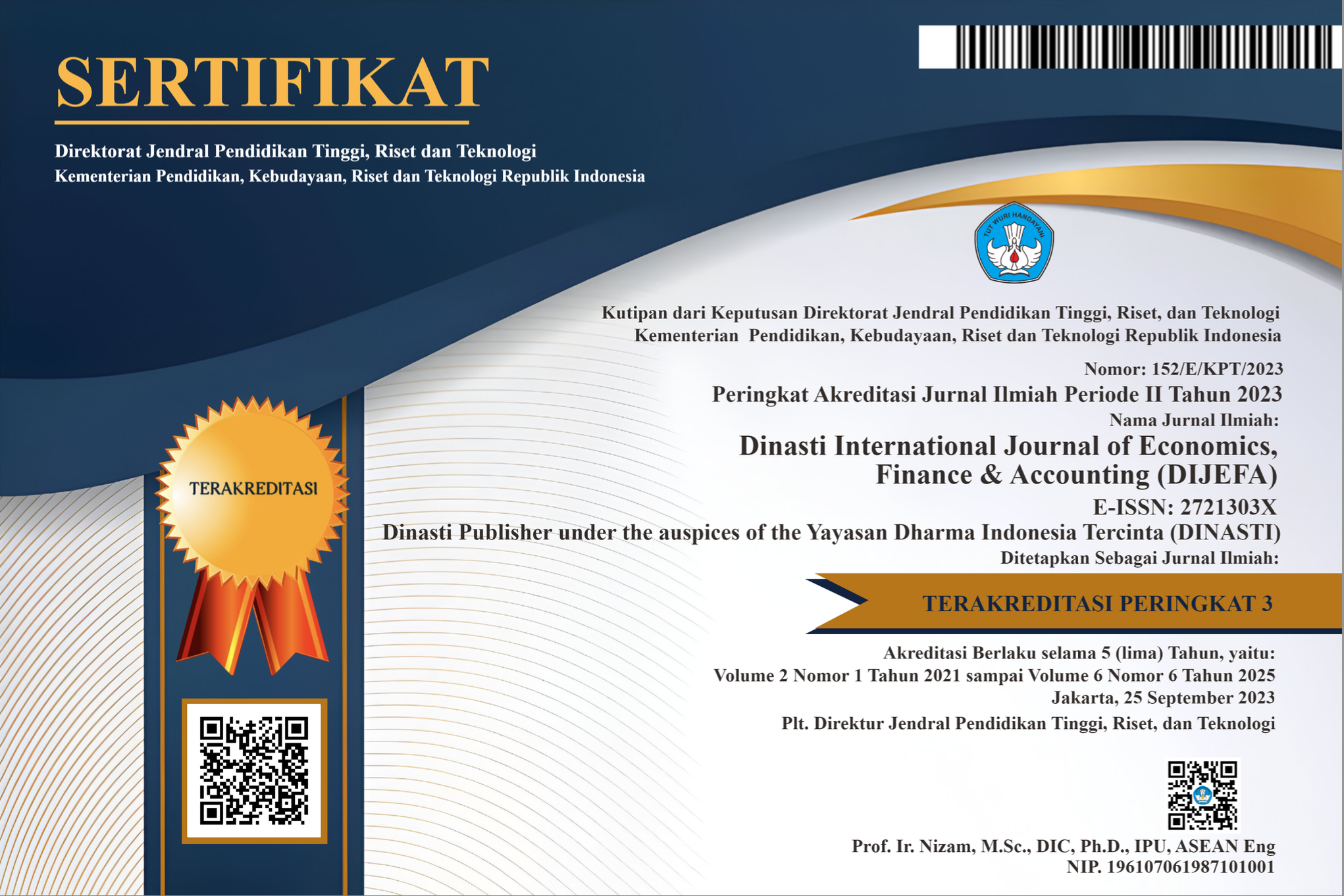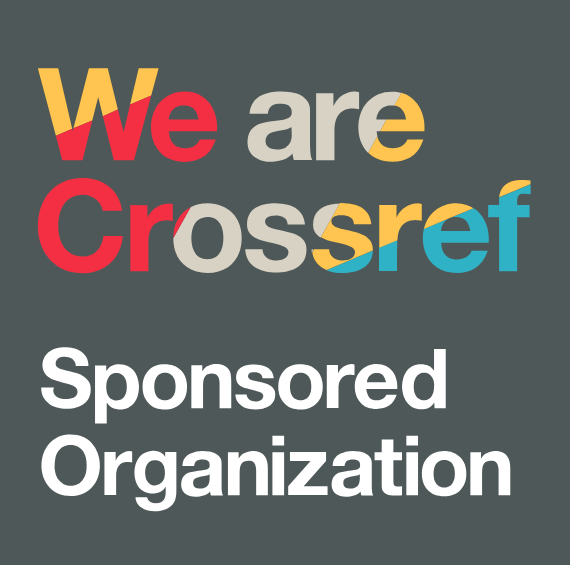The Effect of Islamic Financial Inclusion on Welfare Through Religiosity Based on Tawhidi String Relations
DOI:
https://doi.org/10.38035/dijefa.v3i6.1618Keywords:
Islamic Financial Inclusion, Welfare, Religiosity, Tawhidi Streeng RelationAbstract
Karawang Regency is a rice barn and a large industrial area with a high regional minimum wage (UMR). However, the level of welfare is still a problem for leaders, considering that welfare is always associated with asset ownership measured in rupiah units to ensure financial inclusion in the community. Karawang district is interesting for discussion. This study aims to analyse the effect of Islamic financial inclusion on welfare through religiosity based on Tawhidi string relations, data processing using quantitative data processing techniques with multiple regression analysis, and placing religiosity as an intervening. This study uses primary data collected through questionnaires with a sampling quota of 564 respondents, with the locus of karawang district. The results showed that the path coefficient (mediation) of the indirect effect of inclusion on welfare through religiosity was 0.111 with a z-value (Sobel Test) of (5.132). The direct effect of Islamic financial inclusion (X2) on welfare (Y) through religiosity (X3) is positive and significant if we look at the direct effect of the Islamic financial inclusion coefficient (X2) on improving welfare (Y) of 0.302, this indicates that there is a positive effect of financial inclusion. Sharia is towards improving people's welfare; the more people can access sharia financial inclusion, the higher the level of welfare that the community will enjoy.
References
Abubakar, Habib Auwal. (2015)," Entrepreneurship development and financial literacy in Africa," World Journal of Entrepreneurship, Management and Sustainable Development Vol. 11 No. 4, 2015 pp. 281-294 © Emerald Group Publishing Limited 2042-5961 DOI 10.1108/WJEMSD-04-2015-0020.
Adriani, Diana. I Gst. Bgs, Wiksuana. (2018). "Financial inclusion in relation to the growth of MSMEs and the level of community welfare in the province of Bali," E-Jurnal of Unud Management, Vol. 7, No. 12, 2018: 6420 - 6444 ISSN: 2302-8912 DOI: https://doi.org/10.24843/EJMUNUD.2018.v7.i12.p2 6420.
Amin, at all. (2014)." Theory of Islamic consumer behaviour An empirical study of consumer behaviour of Islamic mortgage in Malaysia." Journal of Islamic Marketing Vol. 5 No. 2, 2014 pp. 273-301 © Emerald Group Publishing Limited 1759-0833 DOI 10.1108/JIMA-06-2013-0042.
Anwar, Muhadjir et al. (2015). "Review of Financial Inclusion Description at Small Industry Centers in East Java." Proceedings of the National Seminar. Research month.
Asaad, C. T. (2015)." Financial literacy and financial behavior: Assessing knowledge and confidence." Financial Services Review, 24(2), 101–118.
Awan, at al. (2011). "Impact of education on poverty reduction." Online at https://mpra.ub.uni-muenchen.de/31826/ MPRA Paper No. 31826, posted 24 Jun 2011 19:33 UTC.
Azwa. (2017). "Empirical analysis of Islamic financial inclusion in Indonesia." Journal of BPPK Volume 10 Number 1 of 2017 Pages 1-21 p-ISSN: 2085-3785. e-ISSN: 2615-7780.
Azzaini. Jamil. (2001). "Looking for Community Empowerment Models." Papers at the National Seminar of the Indonesian Ministry of Agriculture. 2001
Bongomin, at all. (2016). "Social capital: mediator of financial literacy and financial inclusion in rural Uganda." Vol. 26 No. 2, 2016 pp. 291-312 © Emerald Group Publishing Limited 2059-6014 DOI 10.1108/RIBS-06-2014-0072.
Bourguignon, François. (2004)." The Poverty-Growth-Inequality Triangle." Paper presented at ICRIER, New Delhi, in February.
Budiman et al. (2015). "The Relationship between Religiosity and Welfare in the Banjar Community, South Kalimantan." AT - TARADHI Journal of Economic Studies, Volume 6, Number 2, December 2015, p. 207-218.
Cahya, Bayu Tri, (2015). "Poverty in terms of the perspective of the Koran and Hadith." Journal of Research Vol. 9, No. 1, February
Chen. H dan Volpe. (1998), "An Analysis of Personal Financial Literacy among College Students". Financial Services Review,7(2), 107-128.
Dahliana Sukmasari, 2020; "Community welfare in the perspective of the Koran"; AT-TIBYAN Journal Of Qur'an and Hadith Studies Vol. 3 No. June 1, Page 1
Dawood, at all. (2019)." Does financial inclusion alleviate household poverty? Empirical evidence from Indonesia". Economics and Sociology 12(2), 235-252. doi:10.14254/2071-789X. 2019/12-2/14 ISSN 2071-789X.
Defiansih, Kardiyem, 2003; "The role of economic hardship, job satisfaction and religiosity on psychological well-being"; JOURNAL OF PSYCHOLOGY 2003, NO. 2, 72 – 80 ISSN: 0215 – 8884.
Fitriani, Annisa, (2016). "The role of religiosity in increasing psychological well-being". Al-AdYaN/Vol.XI, No.1/January-June/.
Gelaidan, H. M., & Abdullateef, A. O. (2017). "Entrepreneurial intentions of business students in Malaysia: the role of self-confidence, educational and relation support". Journal of Small Business and Enterprise Development, 24(1), 54–67.
Hassan Abul and Shamim Saleem. (2017)." An Islamic microfinance business model in Bangladesh". Humanomics Vol. 33 No. 1, 2017 pp. 15-37 © Emerald Publishing Limited 0828-8666 DOI 10.1108/H-08-2016-0066.
Hadjam, M. Noor Rochman & Arif Nasiruddin. (2003). "The role of economic hardship, job satisfaction, and religiosity on psychological well-being". Journal of Psychology No. 2, 72 – 80 ISSN: 0215 – 8884.
Hamza, Amir. (2019). "Financial literacy and Islamic financial inclusion among Kuningan district educators". Journal of Islamic Accounting and Finance Volume 7(2) October 2019, p. 175-187 P-ISSN: 2338-2783 | E-ISSN: 2549-3876 DOI: https://doi.org/10.35836/jakis.v7i2.76.
Hidayat, Anton. (2007). "Tackling Village Poverty". Article - People's Economy and Poverty.
Hidayanto M. Fajar. (2008) "The practice of usury and social inequality". He usury Islamic economics journal, Vol. II, No. 2, December 2008.
Hidayanto M. Fajar. (2008) "The practice of usury and social inequality". He usury Islamic economics journal, Vol. II, No. 2, December 2008
Iklima Humaira Endra, Murti Sagoro, (2018). "The influence of financial knowledge, financial attitudes, and personality on financial management behavior in SMEs in the batik craft centre of Bantul Regency". Journal Nominal/Volume VII Number 1/ Year 2018.
Irawan & Abdi Setiawan, (2018), "Financial Literacy on Family Welfare through Financial Planning (Demography Study of Tanjung Balai City Community)," Journal of Business and Public Accounting ISSN: 2087-4669 volume 8 No 2.
Kakwani, at all. (2004)," Pro-poor Growth Concepts and Measurement with Country Case Studies". Working Paper No. 1, International Poverty Centre.
Kheir Vivian Bushra, (2018)." The nexus between financial development and poverty reduction in Egypt Received". Review of Economics and Political Science Vol.3No.2,2018 pp. 40-55 EmeraldPublishingLimited 2631-3561 DOI 10.1108/REPS-07-2018-003.
Lusardi dan Mitchell. (2007). "FinancialLiteracy among the Young". The Journal of Consumer Affairs.
Musa, R, & Faridah, H. (2016). " Bridging Islamic financial literacy and halal literacy: The way forward in halal ecosystem". Procedia Economics and Finance, 37, 196-202
Muhammad Zuhirsyan Nurlinda. (2018). "The Influence of Religiosity and Customer Perception on the Decision to Choose a Sharia Bank". Al-Amwal, Volume 10, No. 1 Year 2018 DOI: 10.24235/amwal.v10i1.2812 48.
Mohammad H Holle. (2019). "Financial inclusion is a solution to poverty alleviation for the competitiveness of the nation's economy". Amal, Journal Of Islamic Economics And Business (JIEB) Vol. 01, No. 02 1.
Nandru Prabnhakar at All,2020;" Examining the influence of financial inclusion on financial well-being of marginalised street vendors"; an empirical evidence from India International Journal of Social Economics Vol. 48 No. 8, 2021 pp. 1139-1158 © Emerald Publishing Limited 0306-8293 DOI 10.1108/IJSE-10-2020-0711, https://www.emerald.com/insight/0306-8293.htm
Nengsih, Nonia. (2015). "The Role of Islamic Banking in Implementing Financial Inclusion in Indonesia". Journal of Economics. Volume 14. No 2. Pg 221-240>
Prastowo, (2018). "Regional analysis of financial inclusion of Islamic banking on income inequality in Indonesia". Journal of Islamic Economics & Finance, Faculty of Economics, Islamic University of Indonesia, Yogyakarta Vol. 4 No. 1, January: 51-57 Available at http://journal.uii.ac.id/index.php/jeki
Puspitasari Sindi, et al. (2019). "The index of Islamic financial inclusion in Indonesia in 2015-2018". Amwaluna: Journal of Islamic Economics and Finance Vol. 4 No. January 1, 2020 Page 15 - 31 Online ISSN: 2540-8402 | Print ISSN: 2540-8399.
Rajna, A., Ezat,Sharifah W.P., Junid, Syed Al, dan Moshiri,H. (2011).”Financial Management Attitude and Practice among the Medical Practitioners in Public and Private Medical Service in Malaysia”. International Journal of Business and Management Vol. 6, No. 8, Hlm. 105-113.
Robb, C. A., & Woodyard, A. S. (2011)." financial knowledge and best practice behaviour. Journal of Financial Counseling and planning". Volume 22 Issue 1.
Sadewa Manik Mutiara et al., 2015; "The relationship between religiosity and welfare in the banjar community of South Kalimantan"; AT - TARADHI Journal of Economic Studies, Volume 6, Number 2, December , p. 207-218
Setiawati, Rike dkk. (2018). "I Islamic financial literacy construct process and Validity". Academy of Strategic Management Journal Volume 17, Issue 4, 1939-6104-17-4-242
Shefrin, Hersh. (2000). "Beyond Greed and Fear: Understanding Behavioral Finance and Psychology of Investing". Harvard Business School Press.
Shinkafi Akilu Aliyu dkk, (2020). " Realising financial inclusion in Islamic finance". Journal of Islamic Marketing Vol.11No.1, pp. 143-160 ©EmeraldPublishingLimited 1759-0833.
Sohilauw. (2018)," Moderation of Financial Inclusion on the Relationship between Financial Literacy and SME Capital Structure Decisions", JBIMA (Journal of Business and Management), Vol. 6, No. 2, September 2018.
Suaebah Ebah, Fithri Suciati, Muhammad Zaky, 2021; "Financial literacy through financial inclusion to improve the welfare of farmers of highland Sukabumi horticultural crops"; 3JIMEA | MEA Scientific Journal (Management, Economics, and Accounting) Vol. 5 No. 3.
Twibell, at All. (2008). "Nurses' perceptions of their self-confidence and the benefits and risks of family presence during resuscitation". American Journal of Critical Care, 17(2), 101–111
Wibisono. (2007). ”Making the New Indonesia Work for the Poor”. World Bank Jakarta Office Lampiran 1.a.: Persentase penduduk miskin menurut provinsi, Tahun 1996 – 2005 Perkotaan.
Xia, T., Wang, Z., & Li, K. (2014). "Financial literacy overconfidence and stock market participation". Social indikators Research, 119(3), 1233–1245.
Zia Ikrima Zaleda and Eko Prasetyo. (2018). "Analysis of Financial Inclusion Toward Poverty and Income" Journal of Development Economics: Study of Economic and Development Problems, 19 (1), 2018, 114-125 Inequality http://journals.ums.ac.id, Permalink/DOI: 10.23917/jep .v19i1.5879.
Khalisharani, H. , Johan, I R & Sabri, M. F. “The Influence of Financial Literacy and Attitude Towards Financial Behaviour Amongst Undergraduate Students: A Cross-Country Evidence”. PERTANIKA Journal of Social Sciences & Humanitie, 30(2), 499 -474. https://doi.org/10.47836/pjssh.30.2.03
The Influence of Financial Literacy and Attitude Towards Financial Behaviour Amongst Undergraduate Students: A Cross-Country Evidence
Hanin Khalisharani, Irni Rahmayani Johan and Mohamad Fazli Sabri https://doi.org/10.47836/pjssh.30.2.03
Downloads
Published
How to Cite
Issue
Section
License
Authors who publish their manuscripts in this journal agree to the following conditions:
- The copyright on each article belongs to the author(s).
- The author acknowledges that the Dinasti International Journal of Economics, Finance & Accounting (DIJEFA) has the right to be the first to publish with a Creative Commons Attribution 4.0 International license (Attribution 4.0 International (CC BY 4.0).
- Authors can submit articles separately, arrange for the non-exclusive distribution of manuscripts that have been published in this journal into other versions (e.g., sent to the author's institutional repository, publication into books, etc.), by acknowledging that the manuscript has been published for the first time in the Dinasti International Journal of Economics, Finance & Accounting (DIJEFA).


























































